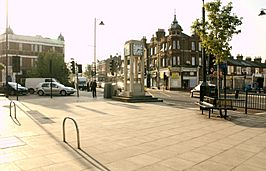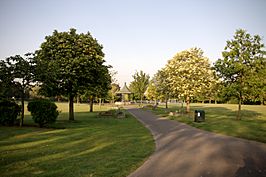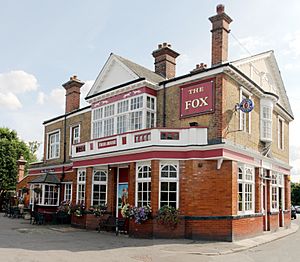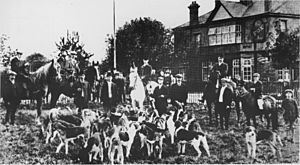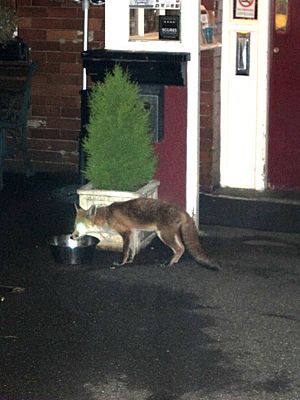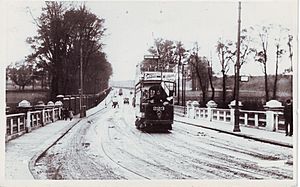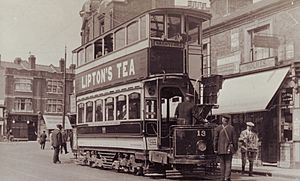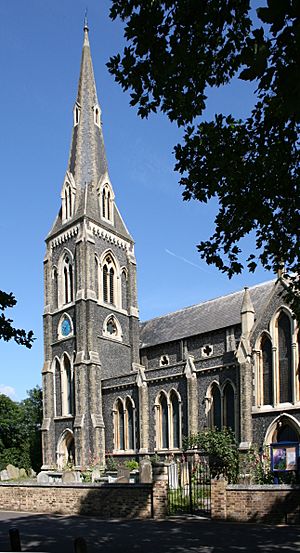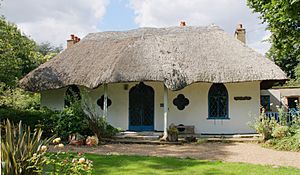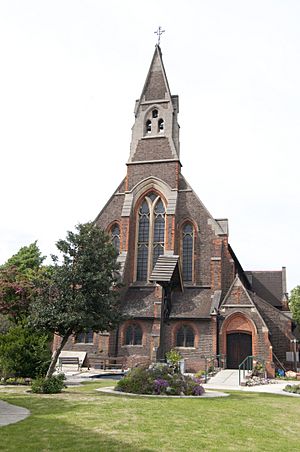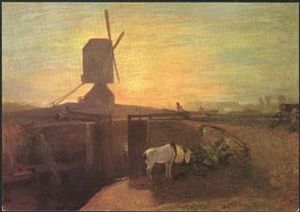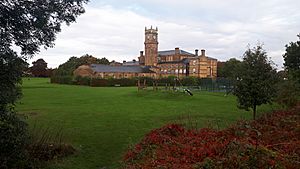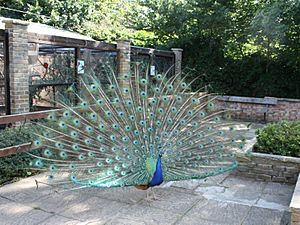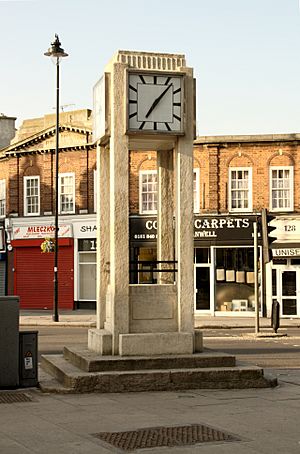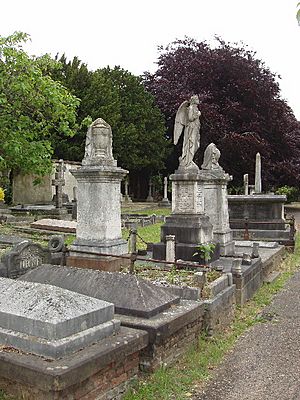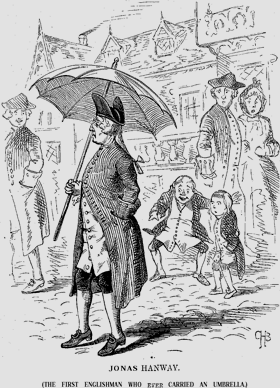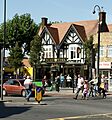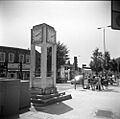Hanwell facts for kids
Quick facts for kids Hanwell |
|
|---|---|
|
From top to bottom: Hanwell Broadway looking east-south-east; Elthorne Park
|
|
| Population | 28,768 (2011 Census |
| OS grid reference | TQ153802 |
| London borough | |
| Ceremonial county | Greater London |
| Region | |
| Country | England |
| Sovereign state | United Kingdom |
| Post town | LONDON |
| Postcode district | W7 |
| Dialling code | 020 |
| Police | Metropolitan |
| Fire | London |
| Ambulance | London |
| EU Parliament | London |
| UK Parliament |
|
| London Assembly |
|
Hanwell is a town located in the London Borough of Ealing. It's about 1.5 miles (2.4 km) west of Ealing Broadway. In 2011, its population was 28,768 people. Hanwell is the westernmost part of the London post town.
Hanwell has a long history, even being mentioned in the Domesday Book. St Mary's Church was first built in the 900s. It has been rebuilt three times, with the current church dating back to 1842. Schools were also started around this time. Famous actor Charlie Chaplin even attended the Central London District School here. By the late 1800s, Hanwell had over a thousand houses.
The Great Western Railway arrived in 1838, and Hanwell railway station opened. Later, in 1904, London United Tramways trams started running on Uxbridge Road. Hanwell was its own district until 1926, when it became part of Ealing.
The River Brent flows to the west of Hanwell, marking its border with Southall. There are many green spaces like Brent Valley Park and Elthorne Park. The Hanwell Zoo is a popular place to visit, with small mammals, birds, and other animals. Hanwell is about 15 meters (49 feet) above sea level. The town also hosts the annual Hanwell Carnival, which is London's oldest carnival.
Contents
- History
- Hanwell Estate
- Places to See and Things to Do
- The Parish Church
- St Thomas the Apostle Church
- St Mellitus Church
- The Wharncliffe Viaduct
- Hanwell Flight of Locks
- Hanwell Community Centre (Old Central London District School)
- Brent Lodge Park and Animal Centre (Hanwell Zoo)
- Brent River Park and Brent Valley Golf Club
- Hanwell Clock Tower
- Elthorne Park
- Cemeteries
- Schools
- Hanwell Hootie
- Sport, Leisure and Media
- Political Representation
- Transport
- Famous People from Hanwell
- Images for kids
- See also
History
What's in a Name?
The name Hanwell probably means 'spring or stream visited by cocks' (a type of bird).
The oldest record of the name is from 959 AD. It was written as Hanewelle. This was when a Saxon named Alfwyn used his land as a promise for money to go on a pilgrimage. The exact origin of the name is not fully known.
Near the old church house (Rectory) and a spring in Hanwell, there's a large stone weighing about one ton. In Anglo-Saxon times, the word Han meant a boundary stone. This might be how the name Han-well came about, even before the Domesday Book.
Old Pubs and Inns
The Uxbridge Road was an important route for travelers. It was improved in 1714, making it easier for people to travel. This led to many coaching inns being built along the road in Hanwell. These inns were places where travelers could rest, stable their horses, and store their goods safely overnight.
One of the first inns was "The Viaduct." It was originally called the "Coach and Horses." You can still see parts of the old stable building from around 1730 behind the pub. In the early 1900s, it got a new, fancy tiled front.
Another important inn was the "Duke of York" at Hanwell Broadway. It was a key stop for stagecoaches traveling between Oxford and London. This inn, built in the 1700s, has been rebuilt in a style that looks like old Tudor buildings.
The "Kings Arms" is another old pub. It was first called the "Spencer Arms." The present building was rebuilt in 1930. Its inside is a great example of the Arts and Crafts Movement style.
Over time, shops started to appear between these inns. This helped them benefit from the many travelers passing by. During the Victorian era, the village grew south of the Uxbridge Road. "The Fox" pub, built in 1848, is a well-preserved Victorian pub. It has won awards and is known for its original features. The Fox was once a meeting place for the local fox hunt. Today, you might even see real foxes drinking from dog bowls outside the pub!
Healthcare History
The Middlesex County Lunatic Asylum, often called the Hanwell Asylum, opened in 1831. It was for poor people with mental health issues. In 1937, it was renamed St Bernard's Hospital. Much of the original building still stands. Part of it is now housing, and part is still a psychiatric hospital.
A doctor named John Conolly worked at the hospital from 1839 to 1844. He was very forward-thinking and avoided using restraints on patients. There's a garden dedicated to him where Station Road and Connolly Road meet.
Hanwell also had other private hospitals. "Popes House" opened around 1804. "Elm Grove House" and "Lawn House" were also private hospitals. Dr. John Conolly ran Lawn House after he left the Hanwell Asylum.
The old "Hanwell Cottage Hospital" was built in 1900. It was paid for by public donations. In 1979, it was replaced by Ealing District General Hospital. A stone pier from the old hospital's entrance was saved as a reminder.
Getting Around: Transport
In 1901, electric trams started running along the Uxbridge Road. This made Hanwell grow even faster than when the trains arrived. The tram company had to make Hanwell Bridge stronger and wider. The lampposts for the streetlights also held up the tram wires. A tram ride from Shepherd's Bush to Uxbridge cost only 8 pence.
A tram depot (a place where trams were stored and fixed) was on the Uxbridge Road. It closed in 1993 and is now a shopping area.
Famous AEC Routemaster buses were built nearby. Their tires were made in Brentford. Trolleybuses were used from 1936 until the early 1960s. There were plans to bring back trams, but these were stopped in 2007.
Hanwell Estate
| Estate name | Area | No of dwellings | Population 1938 | Population density |
|---|---|---|---|---|
| Pre 1914 | ||||
| Norbury | 11 | 218 | 867 | 19.8 per acre (49/ha) |
| Old Oak | 32 | 736 | 3519 | 23 per acre (57/ha) |
| Totterdown Fields | 39 | 1262 | - | 32.4 per acre (80/ha) |
| White Hart Lane Tower Gardens |
98 | 783 | 5936 | 8 per acre (20/ha) |
| 1919-1923 | ||||
| Becontree | 2770 | 25769 | 115652 | 9.3 per acre (23/ha) |
| Bellingham | 252 | 2673 | 12004 | 10.6 per acre (26/ha) |
| Castelnau | 51 | 644 | 2851 | 12.6 per acre (31/ha) |
| Roehampton Estate Dover House Road Estate |
147 | 1212 | 5383 | 8.2 per acre (20/ha) |
| 1924-1933 | ||||
| Downham | 600 | 7096 | 30032 | 11.8 per acre (29/ha) |
| Mottingham | 202 | 2337 | 9009 | 11.6 per acre (29/ha) |
| St Helier | 825 | 9068 | 39877 | 11 per acre (27/ha) |
| Watling | 386 | 4034 | 19110 | 10.5 per acre (26/ha) |
| Wormholt | 68 | 783 | 4078 | 11.5 per acre (28/ha) |
| 1934-1939 | ||||
| Chingford | 217 | 1540 | - | 7.1 per acre (18/ha) |
| Hanwell (Ealing) | 140 | 1587 | 6732 | 11.3 per acre (28/ha) |
| Headstone Lane | 142 | n.a | 5000 | |
| Kenmore Park | 58 | 654 | 2078 | 11.3 per acre (28/ha) |
| Thornhill (Royal Borough of Greenwich) |
21 | 380 | 1598 | 18.1 per acre (45/ha) |
| Whitefoot Lane (Downham) | 49 | n.a | n.a. | |
| Source: Yelling,1995 Rubinstein, 1991, Just like the country. |
The Hanwell estate is a large housing area covering 140 acres (57 ha). It was built between the two World Wars by the London County Council. It has 1,586 houses and flats.
Places to See and Things to Do
The Parish Church
St. Mary's Church is the original church for the area. The church you see today was built in 1841. It was designed by George Gilbert Scott in the Gothic Revival style. The famous painter William Frederick Yeames is thought to have painted the walls inside the church.
A well-known church leader (rector) was Dr. George H. Glasse. His memorial is in St. Mary's Churchyard. He also had a unique house built for him in 1809 called The Hermitage. It looks like a small, fancy Gothic cottage.
Later, Fred Secombe, brother of the famous entertainer Harry Secombe, was also a rector here. He became a popular author after moving back to Wales.
Some people think a pagan place of worship might have been here before the church. This is because of its high location, where the church spire can be seen from far away. However, there is no proof of this.
St Thomas the Apostle Church
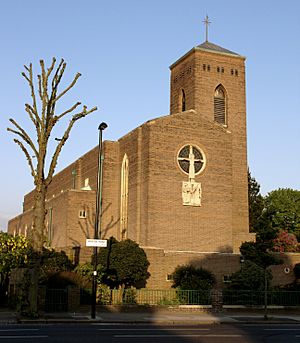
St Thomas's is a very important building. It was designed by Edward Maufe and finished in 1934. The church used special silver-grey bricks and reinforced concrete. Many parts of the inside are similar to Guildford Cathedral, which Maufe also designed.
Outside the Church
The large carving of Jesus on the cross (Calvary) that you see from the road was made by Eric Gill. It forms the design of the East Window. The carving over the north door shows a dove. Inside the north porch, there is a carving of St Matthew by John Skelton.
The carving over the west door shows two birds sharing grapes. This symbolizes Christians sharing the one cup during Communion.
Inside the Church
Inside, the church feels like a grand church made smaller. The main area (nave) and the altar area (chancel) are the same height. There are narrow passages along the sides. The east end is more complex, with different areas like a Lady Chapel and a Children's Corner.
At the west end of the church is the font, used for baptisms. It has carvings of a fish and an anchor, which are symbols for Christ. The stained glass window behind it shows 'Christ and the children'.
The light fittings in the Nave are silver-plated. They have the symbols of the twelve apostles. The floor is made of linoleum. The symbol of St. Thomas the Apostle – a builder's square and three spears – can be seen around the church. The square shows he was a builder, and the spears were used when he was killed.
Sanctuary
The Sanctuary area is dominated by the reredos (a decorated screen behind the altar). It came from another church, St Thomas's Portman Square. The organ also came from that church and was updated.
St Mellitus Church
For many years, St Mary's was the only church in Hanwell. As the population grew, another church, St Mark's, was built in 1877. But even that wasn't enough. So, in 1908, a new area (parish) was created, and St Mellitus Church was built. It was the first church in the Anglican Communion to be named St Mellitus.
The church building is a large, impressive Gothic-style building from the early 1900s. It was designed in 1909 and finished in 1910. It's a well-known landmark with three bells. Funds for the new church came from selling another church in London.
In 1980, St Mellitus and St Mark's churches joined together.
The Wharncliffe Viaduct
This is a very important bridge designed by Isambard Kingdom Brunel. It was his first big project for the Great Western Railway. The viaduct carries trains high across the Brent valley, about 65 feet (20 m) up.
The bridge is made of brick and is 900 feet (270 m) long. It has 8 arches, each 70 feet (21 m) wide. The supporting pillars are hollow and get narrower towards the top.
Originally, the bridge was wide enough for two tracks of Brunel's wide-gauge railway. But in 1846, a law was passed making a narrower track standard across the country. So, in 1847, the viaduct was made wider by adding more pillars and arches on the north side. It is now 55 feet (17 m) wide. In 1892, the wide tracks were changed to standard tracks, allowing for four tracks. Today, it's being updated for electric trains.
The viaduct is still used by trains traveling from Paddington to Bristol. You can see Lord Wharncliffe's coat of arms on the central pillar on the south side. He was the chairman of the Great Western Railway.
Hanwell Flight of Locks
The Hanwell flight of six locks helps boats on the Grand Union Canal go up by over 53 feet (16 m). This area is a protected historical site. At the top of the locks is the Three Bridges, also designed by Isambard Kingdom Brunel. It's near where an old windmill used to stand. This canal and its locks are actually in Southall, but they are named after Hanwell because it's closer.
Hanwell Community Centre (Old Central London District School)
The Central London District School in Hanwell was built between 1856 and 1861. It was a place to house and educate poor children away from workhouses. Its most famous student was Charlie Chaplin, who attended the school from 1896 to 1898.
The school closed in 1933. Parts of it are still standing and are now used as the Hanwell Community Centre. The centre was even used as a filming location for the movie Billy Elliot. It is a protected building. In 2015, the London Welsh School moved into the building.
Brent Lodge Park and Animal Centre (Hanwell Zoo)
This park became a public recreation area in 1931. The original house, Brent Lodge, was taken down. The old stable building is still there and is a protected building.
For many years, the park had a small 9-hole golf course. It also had a large area for unwanted pet rabbits, which is why locals still call it 'Bunny Park'. Later, the animal collection grew to include more exotic animals. It is now a small zoo and a member of the British and Irish Association of Zoos and Aquariums (BIAZA). Since April 2016, it's been called Hanwell Zoo. It's home to animals like Mara, Capybara, Meerkats, Caribbean Flamingo, and Ring-tailed Lemurs.
The park has a modern playground for children. You can see a maze made of 2,000 yew trees from above, planted for the Millennium. There's also a coffee shop.
Brent River Park and Brent Valley Golf Club
Brent Lodge Park is part of the larger Brent River Park. This park follows the river from Perivale down to Hanwell. The Brent Valley Golf Club is also in this river valley.
Hanwell Clock Tower
The Hanwell Clock Tower was officially revealed on Hanwell Broadway on May 7, 1937. This was part of Ealing's celebration for the coronation of King George VI and Queen Elizabeth. The Mayor said Hanwell was "one of the finest gateways to the city of London."
In the early 1970s, some people wanted to demolish the clock tower, calling it an "eyesore." This caused a lot of debate among residents. Many people defended it, saying it was a useful landmark and part of the area's history. They argued it needed to be cleaned, not torn down.
The clock tower was cleaned and restored the following year. Its new look even changed the mind of the person who wanted to demolish it! The tower has been cleaned and restored several times since, including in 2002 for the Queen's Golden Jubilee.
Elthorne Park
The name Elthorne is very old, going back at least a thousand years. It was mentioned in the Domesday survey.
The park's history dates back to the 1500s. The original large estate was called La Bromeland, named after the yellow flowering Broom shrub that still grows there.
In 1908, Lord Jersey started talking with the Council about using the land for public space. He allowed part of it to be used as a temporary recreation ground. The farmland was finally divided around 1910. Some of it became open space and playing fields, and 7.5 acres (3 ha) became Elthorne Park.
Lord Villiers and the Countess of Jersey officially opened the park on June 11, 1910. It was a big event with a large tent and tea. The first event held in the park was a flower show in July 1910.
A large stone, called the Hanwell ‘Sarsen’ Stone, can be seen just inside the main entrance to the park. This stone was left behind by glaciers during the Ice Age.
Cemeteries
There are three burial grounds in Hanwell. The one at St Mary's church is full. The other two are for people from other parts of London.
St. Mary's Church Graveyard
The graveyard of St. Mary's is the oldest burial ground. There is a large stone monument to the Glasses family on the east side of the churchyard.
Westminster City Council Cemetery, Hanwell
Westminster City Cemetery, Hanwell is a cemetery run by Westminster City Council. It has some impressive tombs and family vaults.
Royal Borough of Kensington and Chelsea Cemetery, Hanwell
Royal Borough of Kensington and Chelsea Cemetery, Hanwell is another Victorian cemetery. It is on the north side of the Uxbridge Road. It has an old chapel, gatehouse, and entrance arch designed by Thomas Allom. Many Victorian and Edwardian graves are here.
Ancient Saxon Burials
In 1886, during digging for gravel on Hanwell Common, seven Saxon graves were found. They were found near where Oaklands Primary School is today. At least three of these burials were men with iron spears. Gold-plated copper alloy brooches were also found. You can see them in the Museum of London. These findings show that Saxons lived in Hanwell between the 400s and mid-500s.
When they were first found, some historians thought these were warriors killed in battle. This led to a story about the "Battle of Bloody Croft" around 572 AD, which is still told locally. However, there is no proof that a battle happened there.
Schools
Schools in Hanwell include:
- Brentside High School
- Drayton Manor High School
- Elthorne Park High School
- Hobbayne Primary School
- Brentside Primary Academy
- London Welsh School
- Mayfield Primary School
- Ealing Fields High School
- Oaklands Primary School
- Oaklands Junior School
- St Josephs RC Primary School
- St Mark's Primary School
- Lycée Français Malraux School (a French school)
Hanwell Hootie
In 2013, a special blue plaque was put up near the Hanwell Clock Tower. It honors Jim Marshall, who started Marshall Amplification. He opened his first shop in Hanwell in 1962. To celebrate this, local pubs held a live music festival called the Hanwell Hootie. It was so popular that it became an annual event. Now, many pubs, coffee shops, and delis take part. The festival happens every May.
Sport, Leisure and Media
Hanwell has a football club called Hanwell Town F.C.. They play at Reynolds Field in Perivale. The club was started in 1920 by people from Newcastle upon Tyne who worked in Hanwell. They wear black and white stripes, like Newcastle United. There is also an amateur rugby team, Hanwell RFC.
A community radio station, Westside 89.6FM, broadcasts from studios in Clocktower Mews.
Political Representation
Hanwell is part of two areas for parliamentary elections. The northern part of Hanwell is in Ealing North. Since 2019, it has been represented by James Murray (London politician) from the Labour party. The southern part is in Ealing Southall. Since 2007, it has been represented by Virendra Sharma, also from the Labour party.
For local council elections, Hanwell is divided into two areas: North Hanwell and Hanwell Broadway. Both elect councillors to Ealing Council.
Hanwell is also in the London Assembly area of Ealing and Hillingdon. This area has one assembly member. Since 2012, it has been represented by Dr Onkar Sahota from the Labour party.
Transport
Nearest Railway Stations
- Hanwell railway station: This station was built around 1875-77 and is a protected building. It's about 300 meters north of the main shops on Uxbridge Road. It is served by Elizabeth line trains. The station has recently been updated with new lifts for easy access.
- Castle Bar Park and Drayton Green railway stations also serve Hanwell with trains twice an hour.
- Greenford railway station: You can catch trains to Paddington from here.
Nearest Underground Stations
- Boston Manor (Piccadilly line)
- Ealing Broadway (Central line, District line)
- Northfields (Piccadilly line)
- Perivale (Central line)
Nearest Bus Services
Hanwell is served by many bus routes, including 195, 207, 483, E1, E3, and E11. There are also night bus routes N83 and N207. An express bus, SL8, also stops in Hanwell.
Famous People from Hanwell
Many interesting people have lived in or been connected to Hanwell:
- Thomas Baillie (1796-1863): A British Army officer who named a settlement in New Brunswick, Canada, after Hanwell.
- Steve Benbow (1931–2006): A folk guitar player and singer.
- Edward Augustus Bond (1815–1898): Born in Hanwell, he was a librarian and helped start the Palaeographical Society.
- Al Bowlly: A singer buried in the City of Westminster Cemetery in Hanwell.
- The Brand New Heavies: An acid jazz band whose members went to Drayton Manor High School.
- Charlie Chaplin: The famous actor attended the Central London District School in Hanwell.
- John Conolly: A doctor at the Hanwell Asylum who was known for his kind treatment of patients.
- Peter Crouch: A footballer who attended Drayton Manor High School.
- Deep Purple: This rock band rehearsed for their 1970 album Deep Purple in Rock at the Hanwell Community Centre.
- Ella Eyre: A singer known for "Waiting all Night" by Rudimental.
- Freddie Frinton: A comedian buried in Westminster Cemetery.
- Jonas Hanway: A writer and philanthropist, famous for being the first man to carry an umbrella in London. He is buried in St Mary's Church.
- Jimi Hendrix: The legendary guitarist owned a house in Hanwell, but never lived there.
- Philip Jackson: An actor.
- Anna Brownell Jameson: A writer and feminist.
- Chloe Kelly: A footballer who attended Elthorne Park High School.
- Jim Marshall (1923–2012): The founder of Marshall Amplification, who started his business in a small shop in Hanwell.
- Sir Steve McQueen: A famous artist and film director who attended Drayton Manor High School.
- Fred Secombe (1918–2016): A former vicar of St. Mary's church and the elder brother of Sir Harry Secombe. He became a popular author.
- Sir Montagu Sharpe: A local historian who lived at Brent Lodge.
- Henry Scott Tuke: A painter who lived in Hanwell.
- Rick Wakeman: A keyboardist for the band Yes, who attended Drayton Manor Grammar School.
- William Frederick Yeames: An artist known for his painting And When Did You Last See Your Father?. He lived in Hanwell and was a churchwarden at St Mary's.
Images for kids
-
Confluence of the Grand Union Canal and River Brent
-
Royal Borough of Kensington and Chelsea's cemetery in Hanwell
See also


